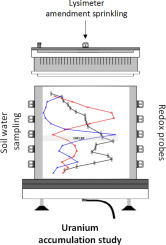当前位置:
X-MOL 学术
›
Sci. Total Environ.
›
论文详情
Our official English website, www.x-mol.net, welcomes your
feedback! (Note: you will need to create a separate account there.)
Origin and stability of uranium accumulation-layers in an Alpine histosol.
Science of the Total Environment ( IF 8.2 ) Pub Date : 2020-04-08 , DOI: 10.1016/j.scitotenv.2020.138368 Jasquelin Peña 1 , Marietta Straub 2 , Virginie Flury 1 , Eymerick Loup 1 , José Corcho 2 , Philipp Steinmann 3 , François Bochud 2 , Pascal Froidevaux 2
Science of the Total Environment ( IF 8.2 ) Pub Date : 2020-04-08 , DOI: 10.1016/j.scitotenv.2020.138368 Jasquelin Peña 1 , Marietta Straub 2 , Virginie Flury 1 , Eymerick Loup 1 , José Corcho 2 , Philipp Steinmann 3 , François Bochud 2 , Pascal Froidevaux 2
Affiliation

|
Uranium (U) accumulation in organic soils is a common phenomenon that can lead to high U concentration in montane wetlands. The stability of the immobilized U in natural wetlands following redox fluctuations and re-oxidation events, however, is not currently known. In this study, we investigated a saturated histosol that had accumulated up to 6000 ppm of U at 30 cm below ground level (bgl). Uranium in the waters feeding the wetland originates from the weathering of surrounding gneiss rocks, a process releasing trace amounts (<3 ppb) of soluble U into nearby streams. Redox oscillations in the first 20 cm bgl led to the accumulation of U, Ca, S in low permeability layers at 30 and 45 cm bgl. XRF measurements along the core showed that U strongly correlates with sulfur (S) and calcium (Ca), but not iron (Fe). We tested the stability of uranium in the histosol over a nine-month laboratory amendment of a large core of the histosol (∅ 30 cm; length 55 cm) with up to 500 ppm nitrate. Nitrate addition was followed by complete nitrate reduction and re-generation of oxidizing Eh conditions in the top 25 cm of the soil without U release to the soil pore waters above background levels (1-2 ppb). Our results demonstrate that, fast reduction of nitrate, sulfate, and Fe(III) occur in the soil without U release. The remarkable stability of sorbed U in the histosol may result from buffering by sulfide and Sn° and/or strong U(IV)-OM or U(VI)-OM enhanced by organic S moieties or bridging complexation by Ca. That U in the soil was immobile under nitrate addition for up to 9 months can inform remediation strategies based on the use of artificial wetlands to limit U mobility in contaminated sites.
中文翻译:

高山组织溶胶中铀堆积层的起源和稳定性。
铀在有机土壤中的积累是一种常见现象,会导致山地湿地中的铀浓度很高。然而,目前尚不知道固定的U在氧化还原波动和再氧化事件之后在天然湿地中的稳定性。在这项研究中,我们研究了一种饱和的组织溶胶,它在低于地面30 cm(bgl)的位置累积了高达6000 ppm的U。供给湿地的水体中的铀来自周围片麻岩的风化作用,该过程将痕量(<3 ppb)的可溶性U释放到附近的溪流中。前20 cm bgl中的氧化还原振荡导致U,Ca,S在30和45 cm bgl的低渗透层中积累。沿岩心的XRF测量表明,U与硫(S)和钙(Ca)密切相关,而与铁(Fe)则不相关。我们在为期9个月的实验室修改中测试了组织溶胶中铀的稳定性,该实验室修改了组织溶胶的大芯(∅30厘米;长度55厘米),硝酸盐含量高达500 ppm。加入硝酸盐后,完全还原硝酸盐并在土壤的顶部25 cm重新生成Eh氧化条件,而没有U释放到高于背景水平(1-2 ppb)的土壤孔隙水中。我们的结果表明,土壤中硝酸盐,硫酸盐和Fe(III)的快速还原没有释放U。在组织溶胶中吸附的U的显着稳定性可能是由于硫化物和Sn°的缓冲作用和/或有机S部分增强的强U(IV)-OM或U(VI)-OM或Ca桥接形成的络合物所致。
更新日期:2020-04-08
中文翻译:

高山组织溶胶中铀堆积层的起源和稳定性。
铀在有机土壤中的积累是一种常见现象,会导致山地湿地中的铀浓度很高。然而,目前尚不知道固定的U在氧化还原波动和再氧化事件之后在天然湿地中的稳定性。在这项研究中,我们研究了一种饱和的组织溶胶,它在低于地面30 cm(bgl)的位置累积了高达6000 ppm的U。供给湿地的水体中的铀来自周围片麻岩的风化作用,该过程将痕量(<3 ppb)的可溶性U释放到附近的溪流中。前20 cm bgl中的氧化还原振荡导致U,Ca,S在30和45 cm bgl的低渗透层中积累。沿岩心的XRF测量表明,U与硫(S)和钙(Ca)密切相关,而与铁(Fe)则不相关。我们在为期9个月的实验室修改中测试了组织溶胶中铀的稳定性,该实验室修改了组织溶胶的大芯(∅30厘米;长度55厘米),硝酸盐含量高达500 ppm。加入硝酸盐后,完全还原硝酸盐并在土壤的顶部25 cm重新生成Eh氧化条件,而没有U释放到高于背景水平(1-2 ppb)的土壤孔隙水中。我们的结果表明,土壤中硝酸盐,硫酸盐和Fe(III)的快速还原没有释放U。在组织溶胶中吸附的U的显着稳定性可能是由于硫化物和Sn°的缓冲作用和/或有机S部分增强的强U(IV)-OM或U(VI)-OM或Ca桥接形成的络合物所致。











































 京公网安备 11010802027423号
京公网安备 11010802027423号